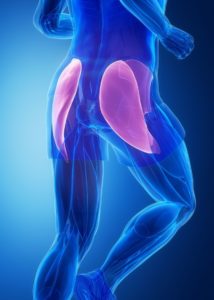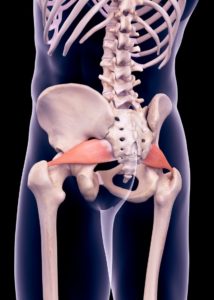What is Piriformis Syndrome?

For Starters, What is a Piriformis?
Whenever patients come into my office experiencing pain in their buttock’s muscles, they usually assume it’s a gluteal muscle strain at work. Before we move on, here’s a quick look at the glutes!
The larger highlighted muscle is your gluteus maximus, the smaller one with a fainter highlight is your gluteus medius. You also have a gluteus minimus located deep beneath both of them!
So, while tight glutes might be the culprit here, there’s the possibility that a deeper and less-talked-about muscle is the one really suffering: the piriformis.
Your piriformis is a small deep semi-triangular muscle, situated behind the gluteus maximus and below the gluteus medius and minimus. It attaches diagonally from the low back (lumbar spine and sacral region) to the great trochanter of the femur (thigh bone). The sciatic nerve, which is responsible for the motor and sensory actions of the lower body, runs through the piriformis and enables its functions: hip rotation, hip abduction, and stabilization of the sacroiliac joint.
Now that you have some basic knowledge of this deep buttock muscle, what is piriformis syndrome? What are its causes? And how can it be treated through our four-step method at Moyer Total Wellness?
What is Piriformis Syndrome?
A few sentences ago, I briefly mentioned the longest nerve in your body known as the sciatic nerve. With piriformis syndrome, the deep buttock muscle spasms, which then compresses the sciatic nerve. This leads to uncomfortable symptoms including:
- Pain in the buttock or hip region
- Numbness and/or tingling starting at the buttocks and traveling down leg
- The symptoms may worsen with long periods of sitting, or after performing functions in which the piriformis assists: walking, running, climbing, etc.
- Weakness and impaired mobility in lower body
What Causes Piriformis Syndrome?
- Direct trauma to the buttock region
- Overuse of the piriformis muscle
- Prolonged and/or high-impact activities involving the piriformis, such as long-distance running
- Post-surgery injury
- Medical conditions affecting the lumbar or sacroiliac joints
- Shortening of the piriformis muscle
- Often due to poor body mechanics
Our Four-Step Method for Treating Piriformis Syndrome
Our approach at Moyer Total Wellness has four goals: remove muscular adhesions, lengthen shortened tissues, strengthen weakened muscles, improve joint mobilization. What are the best modalities for releasing the piriformis? How can we free up the lumbar and sacroiliac joints
As is the case with almost any musculoskeletal condition, deep tissue massage and myofascial release are effective treatments for muscular adhesions. In treating piriformis syndrome, the massage therapist will start with slow methodical strokes on the fascial layer atop the gluteal muscles, followed by deeper strokes into the fibers of the gluteal muscles. The gluteal muscles, being superficial to the piriformis below, have to be released before the piriformis receives the same treatment.
Keep in mind that myofascial release and deep tissue massage, while therapeutic, can be mildly uncomfortable when applied to the buttock muscles due to the buildup of trigger points in the piriformis. For this reason, a patient should always communicate to the therapist if the discomfort becomes actual pain. To know the difference between pain and therapeutic discomfort, here’s the rule: if you’re holding your breath or feel your muscles tensing up with pressure application, the massage is too deep and the adhesed tissues won’t release.
For strengthening and mobilization, assisted stretches targeting the buttocks, hips, and upper leg are an effective way to regain proper functioning in the piriformis and the joints associated with it. Proprioceptive neuromuscular facilitation, or PNF stretching is a technique that both strengthens muscle and improves flexibility. To treat piriformis syndrome, a bodywork practitioner will assist with the stretching of a limb (the leg, in the case of piriformis-targeted stretches) and take it to its full range of motion. The patient will then press the leg in the opposite direction of the stretch, creating resistance which contracts the muscle. After holding that resistance for a couple of seconds, the patient will relax the limb momentarily, and the PNF stretch will be repeated 1-2 more times. In most cases, PNF improves joint range of motion immediately after the first stretch.
The Importance of Intervention
Piriformis syndrome is a common and highly treatable condition. It’s important to seek non-invasive types of treatment, such as bodywork or physical therapy, in the early stages to avoid the possibility of requiring surgery.
Now You Know!
Schedule a consultation, massage, or therapeutic stretching session with one of our talented practitioners!

Katrina Jenkins
Author, Licensed Massage Therapist
Katrina Jenkins graduated from Towson University in 2013 with a Bachelor’s Degree in Health Science and worked as a nurse’s aide briefly before pursuing her true passion. She graduated from the Massage Therapy Institute of Colorado in April 2016 with honors and completed the Touch of Healers Scholarship Program the following summer. She has been a part of the Moyer Total Wellness Team since the summer of 2017.
Resources
Chang, Carol, et al. “Anatomy, Bony Pelvis and Lower Limb, Piriformis Muscle.” PubMed, StatPearls Publishing, 2022, www.ncbi.nlm.nih.gov/books/NBK519497/#:~:text=The%20piriformis%20muscle%20rotates%20the. Accessed 16 May 2022.
FAANS, Jay Jagannathan, MD. “Sciatic Nerve Anatomy.” Spine-Health, www.spine-health.com/conditions/spine-anatomy/sciatic-nerve-anatomy#:~:text=A%20combination%20of%205%20nerve.
“Piriformis Syndrome.” Physiopedia, www.physio-pedia.com/Piriformis_Syndrome.
Photo Credit
Canva by SergeyChayko
Canva by janulla
Canva by Science Photo Library


